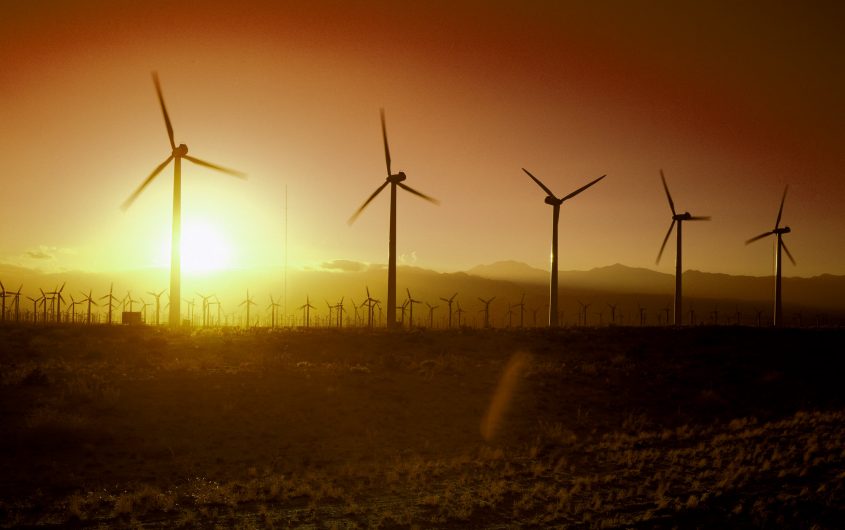
Carol M. Highsmith via Flickr
Climate Politics under Trump: The United States Climate Alliance

Leon Lieblang
University of Duisburg-Essen
Leon Arvid Lieblang is a Geoeconomics non-resident Fellow and former NRW Fellow at AICGS in October and November 2019. He is a research assistant and PhD candidate at the University of Duisburg-Essen, Germany.
Mr. Lieblang’s research focuses on climate and renewable energy policy. he lectures on energy policy and public administration. Mr. Lieblang holds a bachelor’s degree in Politics, Law, and Economics from the University of Erfurt and a master’s degree in Political Management, Public Policy, and Public Administration from the NRW School of Governance. Additionally, he has studied abroad at Sciences Po Lyon, France, and at the Uniwersytet Jagielloński in Kraków, Poland.
Prior to his PhD studies, Mr. Lieblang worked as an advisor at the Ministry of Economic Affairs and Energy of North Rhine-Westphalia. In his position in the Minister’s Office, his responsibilities included strategic planning, coordinating the state government’s agenda, and writing speeches for the minister.
During his stay at AICGS, he worked on U.S. climate policy at the state and federal levels. His research compared various U.S. states' approaches to dealing with U.S. withdraw from the Paris Agreement announced by President Donald Trump. Specifically, Mr. Lieblang assessed which states are developing their own climate agendas, their motivations for doing so, and possible relevant explanatory factors.
Please feel free to contact Mr. Lieblang at leon.lieblang@uni-due.de.
The Paris Agreement is a milestone in the fight against climate change. Contracting parties aim to limit global warming to below 2 degrees—if possible below 1.5 degrees—compared with the pre-industrial era. Hence, international criticism was notable when President Donald Trump announced the planned withdrawal from the Agreement on June 1, 2017, in the White House Rose Garden:
“[I]n order to fulfill my solemn duty to protect America and its citizens, the United States will withdraw from the Paris Climate Accord […] but begin negotiations to reenter either the Paris Accord or a really entirely new transaction on terms that are fair to the United States, its businesses, its workers, its people, its taxpayers. So we’re getting out.”
The president’s critical view had already become apparent in the months before.[1] Nevertheless, key representatives from politics and businesses within the United States expressed their criticism.
Furthermore, on the same day the withdrawal was announced, several U.S. states founded the United States Climate Alliance (USCA). Their reaction is not only embedded in a long tradition of the states as a counterbalance to the federal level both in climate politics and other policy fields. It also raises the question of how U.S. states deal with a restrained climate policy agenda on the federal level. Is state cooperation like in the case of the USCA a solution? The following article examines this question in three aspects: the USCA and its main principles; whether the USCA is symbolic politics or a serious attempt to influence U.S. climate policies; and possibilities and limits for states to pursue an independent climate agenda are outlined
Federalism and Climate Politics in the U.S.
Since the beginning of the rise of climate change, it was mainly perceived as a problem that should be dealt with on the international stage with the participation of national states at international conferences.[2] The results of the conferences—such as the Kyoto Protocol or the Paris Agreement—were seen as proof of their importance. Recently, the inability to agree on compulsory restrictions and recent setbacks like the 2019 United Nations Climate Change Conference broadened the view. Additionally, in the case of the U.S., rising partisan and institutional barriers on the federal level become more apparent, resulting in an anticipated “Turn to the States.”[3] As a result of the election of Donald Trump as President of the United States, the debate about federal-state leadership is again on the rise. However, how states execute their leadership is less known and systemized, probably because the phenomenon “has emerged selectively.”[4] Literature so far provides only a few aspects and strategies of state leadership. These include federal states as “laboratories of democracy,” a phrase used by Supreme Court Justice Louis Brandeis in a dissenting opinion in 1932.[5] A similar approach is policy innovation.[6] States seem to be motivated to pool risks[7] and in state cooperation, the appearance of state leadership has been observed.[8] In climate politics, leading states appear to be those that are “already (…) the cleanest.”[9] Successful policies can lead to their diffusion.[10] In some cases, instruments used can be considered symbol politics.[11]
The United States Climate Alliance
The United States Climate Alliance (USCA) describes itself as “a bipartisan coalition of governors committed to reducing greenhouse gas emissions consistent with the goals of the Paris Agreement.” The Alliance was founded on June 1, 2017, the same day that President Trump officially announced the withdrawal. Three states, namely California, New York, and Washington, were the founding members. These states also took a leading role as opponents to federal environmental agencies before, e.g., during the George W. Bush administration.[12] Since its founding, the number of members has grown constantly and currently includes twenty-four U.S. states and Puerto Rico. With a population of roughly 179.5 million, it significantly exceeds the population of non-member states (roughly 148 million).[13] Furthermore, roughly 60 percent of U.S. GDP is currently covered by the member states.[14] On the other hand, more than 55 percent of the state energy-related carbon dioxide emissions by year are emitted by non-members of the USCA.[15] Although other initiatives such as We are still in, a coalition of cities, businesses, and organizations speaking up against the withdrawal exist, the focus on states is unprecedented to this extent.
The Alliance sees itself as an inspiration for other U.S. states but addresses countries abroad as well. The Alliance has three major principles: First, a continuous lead on climate change; second, an understanding that climate action taken at the state level leads to economic benefits and a strengthened community by job creation and establishing resilient communities; and third, proving a general achievability of ambitious climate action plans. Furthermore, the membership is linked to certain commitments, namely the implementation of policies that lead to the compliance of the Paris Agreement goals (reduction of greenhouse gas emissions by at least 26-28 percent until 2025 in comparison to 2005), tracking and reporting on progress achieved aimed at the international community, and improving existing policies and promoting progress on the state and federal level.
Symbol Politics and Limits of Influence
Regarding the question of why states join the Alliance, several influential factors can be considered. The most obvious is partisan affiliation. It is striking that out of twenty-four members, twenty-one have a Democratic governor. This is further supported by the fact that the Alliance was a direct response to the president’s decision to withdraw from the Paris Agreement. One could even consider explaining the membership exclusively by partisan affiliation. The polarization in the U.S., especially notable in climate politics and linked to the instruments used like in the case of the Clean Power Plan[16] could serve as one explanation for this. However, this would fall short for two reasons. First, the Alliance describes itself as “truly bipartisan.” Second, even though for twenty-one member states this explanation might be sufficient, there are only five cases of “rogue” states, meaning that they have either a Democratic governor and did not join the Alliance or have a Republican governor and did join. Specifically, two U.S. states have a Democratic governor and are not members of the Alliance (Kansas, Louisiana) and three states have a Republican governor but are members of the Alliance (Maryland, Massachusetts, Vermont).
The interviews back the assumptions and provide further insights. On the one hand, joining the Alliance is largely dependent on the party affiliation of the states’ governor. Even Republican-led states with an advanced climate policy agenda who could manage to fulfill the Paris Agreement goals do not join. On the other hand, factors for deviant states lie within these states. The industrial share, lobbying, the private sector, and socio-economic reasons were considered plausible explanations. For Republican governors, progressive environmental strategies might play an important role. Literature provides additional findings: It has been mentioned before that in Maryland, Massachusetts, and Vermont, the Republican governors tend to have different policies than other Republican-led states. These consist explicitly of bipartisan approaches and progressive environmental policies. Two examples are Massachusetts governor Charles Baker and Vermont governor Philip Scott, who issued a letter to the Trump administration urging the U.S. to stay in the Paris Agreement. Additionally, party domination in state legislatures and other elected offices might serve as an explanation for these cases.
Other important factors for the analysis are the possibilities and limitations of the states. The experts interviewed showed that advantages lie in particular in a better knowledge of regional conditions. The possibility of exchanging ideas and developing alternative policies is also important in the states. This ultimately creates a reservoir of people and strategies at state level that could be used in terms of best practices with regard to a potential change of government at the federal level. In addition, cooperation can induce policy learning, which develops effects through harmonization of standards and problem-sharing. In addition, members of the USCA can at least passively participate in international conferences. Nevertheless, there are limits to the possibilities at the state level. This applies in particular to financial support from the state level, not only within the U.S., but also from the international community. Nor can associations such as the USCA sign international agreements. Finally, some policy instruments such as emission trading systems are much more effective at the federal level.
Conclusion: The USCA – More than Symbolic Politics?
The USCA is an alliance of almost half of the U.S. states that was founded in response to the announced withdrawal of the U.S. from the Paris Agreement. The main objective is to maintain the goals agreed in the Paris Agreement. Concerning the question of whether the Alliance is symbolic politics or a serious attempt at addressing climate change, it can be stated that the alliance enables an exchange of best practices. This coincides with the strategies of states known from the literature that are used to implement a leadership claim. However, the lack of federal funding is a major hurdle and legal limits such as the lack of opportunity to negotiate international agreements limit the potential of the alliance. On the other side, several factors speak—also according to the interviewees—in favor of symbolic politics. Aiming at the international community, the alliance signals that there are still voices in the U.S. opposed to the climate politics pursued at the federal level. Financial dependencies in particular further limit the Alliance’s options as a political counterweight at the state level. At the same time, it would be wrong to speak of symbolic politics only, as the exchange between the states and the development of policies is certainly beneficial. The USCA is to be seen first and foremost as an alliance in which counter-proposals to federal policies are developed in the sense of a “laboratory of democracy.” The states can test which policies are suitable for reducing emissions and contribute to policy learning and best practices. The fact that this is done, although to a limited extent, across party lines is a remarkable success in light of the current polarization of the U.S.
This essay is a summary of the article “A ‘Turn to the States’? Climate Politics under Trump Administration and the United States Climate Alliance.” The analysis includes the findings of five semi-structured interviews conducted with experts in Washington, DC. For this purpose, a qualitative content analysis was applied according to Mayring.[17] A version of this article in German is available on regierungsforschung.de.
[1] Cooper (2018): Governing the global climate commons: The political economy of state and local action, after the U.S. flip-flop on the Paris Agreement, in: Energy Policy. Vol. 118, p. 440–454.
[2] Rabe (2011): Contested Federalism and American Climate Policy, in: The Journal of Federalism. Vol. 41 (3), p. 494–521.
[3] Trachtman (2019): Building Climate Policy in the States, in: The Annals of the American Academy of Political and Social Science. Vol. 685 (1), p. 96–114.
[4] Harrison (2013): Federalism and Climate Policy Innovation: A Critical Reassessement, in: Canadian Public Policy / Analyse de Politiques. Vol. 39, p. S95–S108.
[5] New State Ice Co. v. Liebmann, 285 U.S. 262, 311 (1932); for further explanations see Tarr (2001): Laboratories of Democracy? Brandeis, Federalism, and Scientific Management, in: Publius. Vol. 31 (1 (Essays in Memory of Daniel J. Elazar)), p. 37–46.
[6] Engel (2006): Harnessing the Benefits of Dynamic Federalism in Environmental Law, in: Emory Law Journal. Vol. 56, p. 159–188.
[7] Harrison (2013): Federalism and Climate Policy Innovation: A Critical Reassessement, in: Canadian Public Policy / Analyse de Politiques. Vol. 39, p. S95–S108.
[8] Konisky und Woods (2018): Environmental Federalism and the Trump Presidency: A Preliminary Assessment, in: The Journal of Federalism. Vol. 48 (3), p. 345–371.
[9] Harrison (2013): Federalism and Climate Policy Innovation: A Critical Reassessement, in: Canadian Public Policy / Analyse de Politiques. Vol. 39, p. S95–S108.
[10] Fisher (2013): Understanding the relationship between subnational and national climate change politics in the United States: toward a theory of boomerang federalism, in: Environment and Planning C: Government and Policy. Vol. 31, p. 769–784.
[11] Harrison (2013): Federalism and Climate Policy Innovation: A Critical Reassessement, in: Canadian Public Policy / Analyse de Politiques. Vol. 39, p. S95–S108.
[12] Konisky und Woods (2018): Environmental Federalism and the Trump Presidency: A Preliminary Assessment, in: The Journal of Federalism. Vol. 48 (3), p. 345–371.
[13] United States Census Bureau (2019): State Population Totals: 2010–2019. Online available: https://www.census.gov/data/tables/time-series/demo/popest/2010s-state-total.html#par_textimage_1574439295. and own calculations.
[14] U.S. Bureau of Economic Analysis (2019): Gross Domestic Product by State. First Quarter 2019. Online available: https://www.bea.gov/data/gdp/gdp-state.and own calculations.
[15] U.S. Energy Information Administration (2019): Energy-Related Carbon Dioxide Emissions by State, 2005–2016. February 2019. Online available: https://www.eia.gov/environment/emissions/state/analysis/pdf/stateanalysis.pdf.and own claculations.
[16] Fisher et al. (2018): Polarizing Climate Politics in America, in: Environment, Politics, and Society (Research in Political Sociology). Vol. 25, p. 1–23.
[17] Mayring (2015): Qualitative Inhaltsanalyse. Grundlagen und Techniken. Beltz Verlag, 12th, revised edition, Weinheim and Basel.









